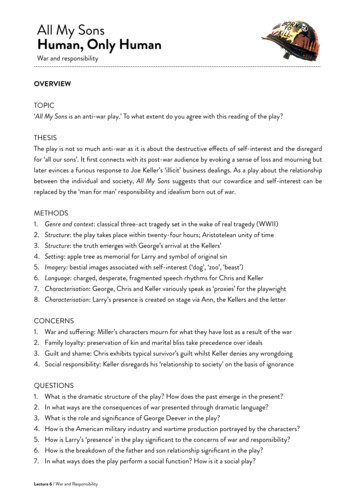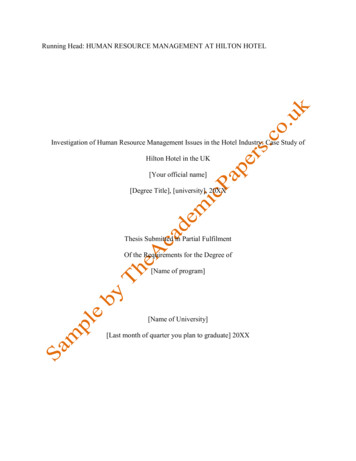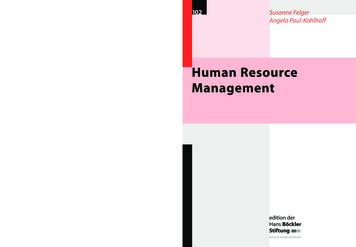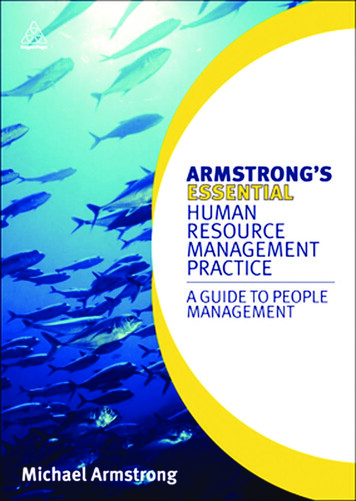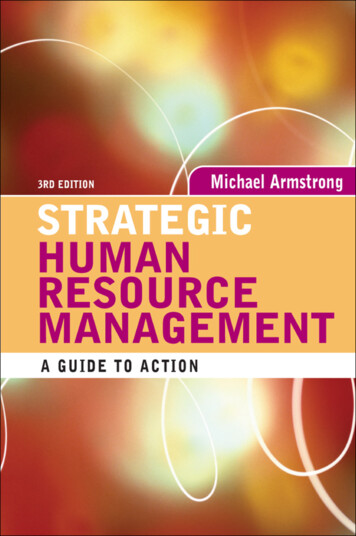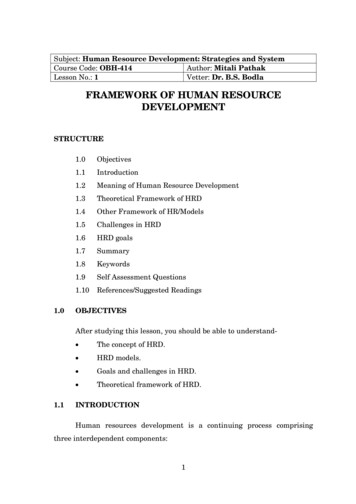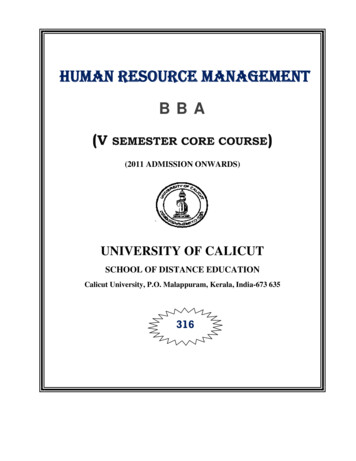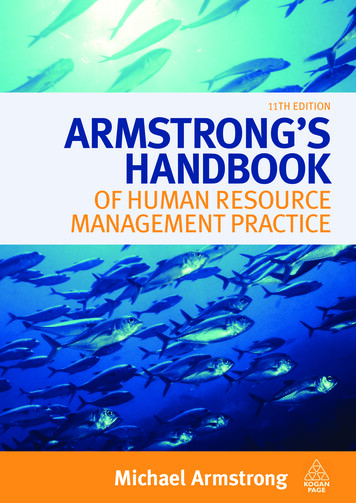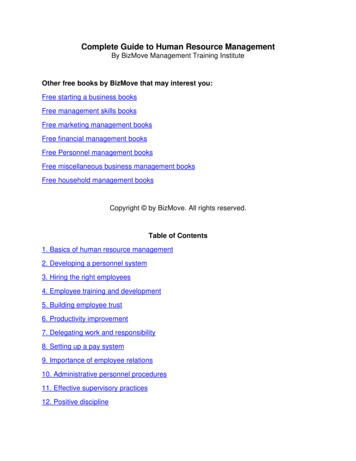
Transcription
Complete Guide to Human Resource ManagementBy BizMove Management Training InstituteOther free books by BizMove that may interest you:Free starting a business booksFree management skills booksFree marketing management booksFree financial management booksFree Personnel management booksFree miscellaneous business management booksFree household management booksCopyright by BizMove. All rights reserved.Table of Contents1. Basics of human resource management2. Developing a personnel system3. Hiring the right employees4. Employee training and development5. Building employee trust6. Productivity improvement7. Delegating work and responsibility8. Setting up a pay system9. Importance of employee relations10. Administrative personnel procedures11. Effective supervisory practices12. Positive discipline
13. Dealing with employee grievances14. Communicating with your employees15. Managing employee benefits16. Developing a training program17. Using temporary help services1. Basics of Human Resource ManagementPersonnel management is concerned with the effective use of the skills of people. Theymay be salespeople in a store, clerks in an office, operators in a factory, or techniciansin a research laboratory. In a business, personnel management starts with the recruitingand hiring of qualified people and continues with directing and encouraging their growthas they encounter problems and tensions that arise in working toward establishedgoals.In addition to recruiting and hiring, some of the responsibilities of a personnel managerare:1. To classify jobs and prepare wage and salary scales.2. To counsel employees.3. To deal with disciplinary problems.4. To negotiate with labor unions and service union contracts.5. To develop safety standards and practices.6. To manage benefit programs, such as group insurance, health, and retirement plans.7. To provide for periodic reviews of the performance of each individual employee, andfor recognition of his or her strengths and needs for further development.8. To assist individuals in their efforts to develop and qualify for more advanced jobs.9. To plan and supervise training programs.10. To keep abreast of developments in personnel management.To understand the personnel manager's job think of how you would deal with thefollowing examples of challenging employee situations:The firm's employees - especially the most qualified ones - can get comparable, if notbetter jobs with other employers.
When a firm faces a scarcity of supervisory and specialized personnel with adequateexperience and job capabilities, it has to train and develop its own people. This can betime consuming and expensive.The cost of hiring and training employees at all levels is increasing, for instance, severalthousand dollars for a salesperson. A mistake in hiring or in slow and inefficientmethods of training can be costly.Personnel managers must comply with the law by employing, training and promotingwomen and persons from minority groups. The problem in doing so is that many ofthese employees have not had appropriate experience and education in the past.Most employees, whether or not represented by labor unions, continue to seekimprovements in direct compensation, employee benefits, and working conditions. Allcommitments must be based upon what the firm can afford, comply with currentpractices of other employers, and be understood and accepted by the employee. To dothis, all employee policies and operating procedures should be developed andnegotiated with great care.Some employees may not perform satisfactorily simply because their firm offerscompetitive compensation, benefits, and working conditions. In addition to thesefinancial or physical compensations, they want responsibility, the opportunity to develop,and recognition of accomplishment in their jobs.The law have established requirements for pension and other benefit plans, and alsobar mandatory retirement at age 65. Complying with such changes presents realchallenges.Personnel management works to achieve practical solutions to such problems. In largefirms, it generally provides support to line management. In this staff capacity, thepersonnel department has the responsibility to develop and implement policies,procedures, and programs for recruitment, selection, training, placement, safety,employee benefits and services, compensation, labor relations, organization planning,and employee development.Often, the owner-manager of a firm also has to be the personnel manager. In such acase it is necessary to have an overview of current trends and practices in personnelmanagement.All small businesses must staff their operations. This involves bringing new people intothe business and making sure they are productive additions to the enterprise. Effectivehuman resource management matches and develops the abilities of job candidates andemployees with the needs of the firm. A responsive personnel system will assist you inthis process and is a key ingredient for growth.Human resource management is a balancing act. At one extreme, you hire onlyqualified people who are well suited to the firm's needs. At the other extreme, you trainand develop employees to meet the firm's needs. Most expanding small businesses fallbetween the two extremes i.e., they hire the best people they can find and afford, and
they also recognize the need to train and develop both current and new employees asthe firm grows.One function of personnel management deals with how to hire and train the right peopleand addresses the characteristics of an effective personnel system, such as:Assessing personnel needs.Recruiting personnel.Screening personnel.Selecting and hiring personnel.Orienting new employees to the business.Deciding compensation issues.Another function addresses the training and development side of human resourcemanagement. A third function deals with how the personnel system and the training anddevelopment functions come together to build employee trust and productivity. Thesethree functions stress the importance of a good human resource management climateand provide specific guidelines for creating such a climate.Human Resource Management Audit QuestionnaireDoes the business have a plan for forecasting long-term personnel needs?Are there guidelines for hiring personnel, or are employees hired based on gut feelings?Are there job descriptions for all positions?What do employees like about their jobs?What do employees dislike about their jobs?Why do employees leave the organization?Is there an active training program? Is it based on an assessment of where the firm isnow or where it should be in the future?Are a variety of training programs available?How is morale in the firm?Do employees really believe what you have to say?Are all employees treated fairly?Go to Top
2. Developing a Personnel SystemAssessing Personnel NeedsThe small business owner should base the firm's personnel policies on explicit, wellproven principles. Small businesses that follow these principles have higherperformance and growth rates than those that do not follow them. The most important ofthese principles areAll positions should be filled with people who are both willing and able to do the job.The more accurate and realistic the specifications of and skill requirements for each job,the more likely it is that workers will be matched to the right job and, therefore, be morecompetent in that job.A written job description and definition are the keys to communicating job expectationsto people. Do the best job you can! is terrible job guidance.Employees chosen on the basis of the best person available are more effective thanthose chosen on the basis of friendship or expediency.If specific job expectations are clearly spelled out, and if performance appraisals arebased on these expectations, performance is higher. Also, employee training results inhigher performance if it is based on measurable learning objectives.The first step in assessing personnel needs for the small business is to conduct an auditof future personnel needs. Ask yourselfCan the workload you visualize be accomplished by the present work force? Will moreor fewer employees be needed? Consider seasonal patterns of demand and probableturnover rates.Can any jobs be eliminated to free people for other work?What balance of full-time or part-time, temporary or permanent, hourly or salariedpersonnel do you need?What does the labor supply look like in the future?Will you be able to fill some of the jobs you've identified? How easily?What qualifications are needed in your personnel?Develop a method to forecast labor demand based on your answers to these questions.Once your needs are estimated, determine strategies to meet them.The process of selecting a competent person for each position is best accomplishedthrough a systematic definition of the requirements for each job, including the skills,knowledge and other qualifications that employees must possess to perform each task.To guarantee that personnel needs are adequately specified, (1) conduct a job analysis,(2) develop a written job description and (3) prepare a job specification.
Job AnalysisJob analysis is a systematic investigation that collects all information pertinent to eachtask performed by an employee. From this analysis, you identify the skills, knowledgeand abilities required of that employee, and determine the duties, responsibilities andrequirements of each job. Job analysis should provide information such asJob title.Department.Supervision required.Job description-major and implied duties and responsibilities.Unique characteristics of the job including location and physical setting.Types of material used.Types of equipment used.Qualifications.Experience requirements.Education requirements.Mental and physical requirements.Manual dexterity required.Working conditions (inside, outside, hot, cold, dry, wet, noisy, dirty, etc.).Job DescriptionThe job analysis is used to generate a job description, which defines the duties of eachtask, and other responsibilities of the position. The description covers the various taskrequirements, such as mental or physical activities; working conditions and job hazards.The approximate percentage of time the employee should spend on each activity is alsospecified. Job descriptions focus on the what, why, where and how of the job.There is an excellent resource the small business owner can use to develop jobdescriptions, ask employees themselves to describe their jobs. A good employee mayknow more about the job than anyone else.Job SpecificationThe job specification describes the person expected to fill a job. It details the knowledge(both educational and experiential), qualities, skills and abilities needed to perform thejob satisfactorily. The job specification provides a standard against which to measurehow well an applicant matches a job opening and should be used as the basis forrecruiting.
RecruitingAs a small business owner-manager, you should be aware of the legal environment inwhich you operate. This is especially true when it comes to recruitment. Being aware oflegislation that will affect your business is extremely important to efficient recruiting.Sources of EmployeesEffective recruiting requires that you know where and how to obtain qualified applicants.It is difficult to generalize about the best source for each business, but a description ofthe major sources follows.Present employees - Promotion from within tends to keep employee morale high.Whenever possible, current employees should be given first consideration for any jobopenings. This practice signals your support of current employees.Unsolicited applicants - Small businesses receive many unsolicited applications fromqualified and unqualified individuals. The former should be kept on file for futurereference. Good business practice suggests that all applicants be treated courteouslywhether or not they are offered jobs.Schools - High schools, trade schools, vocational schools, colleges and universities aresources for certain types of employees, especially if prior work experience is not a majorfactor in the job specification. Schools also are excellent sources for part-timeemployees.Private employment agencies - These firms provide a service for employers andapplicants by matching people to jobs in exchange for a fee. Some fees are paid by theapplicants, and there is no cost to the employer; for highly qualified applicants in shortsupply, the employer sometimes pays the fee.Employee referrals - References by current employees may provide excellentprospects for the business. Evidence suggests that current employees hesitate torecommend applicants with below average ability. Word of mouth is one of the mostcommonly used recruiting sources in the small business community."Help Wanted" advertising - Letting people know that the business is hiring is a keyelement in gaining access to the pool of potential employees. At its simplest, this type ofadvertising may take the form of a Help Wanted sign in the window. More sophisticatedmethods involve using local media, primarily print sources such as daily and weeklynewspapers. The classified pages of newspapers are frequently consulted by active jobseekers, including currently employed individuals who may be tempted by a moreattractive position. Other advertising media include radio and television. These tend tohave a wider appeal than the newspaper; however, the price of an advertisement iscorrespondingly higher.Specialty media publications, such as trade association magazines and newsletters,may also produce quality job applicants. There are efforts in some parts of the country
to offer small business employers access to cable television community bulletin boards.Another high-tech opportunity is to list positions on computer network bulletin boards.Prices for help wanted advertising vary and the small business owner approaches themwith caution. A well-placed, h
Complete Guide to Human Resource Management By BizMove Management Training Institute . Other free books by BizMove that may interest you: Free starting a business books Free management skills books . Free marketing management books Free financial management books . Free Personnel management books Free miscellaneous business management books


